Are you new to cooking with carbon steel knives? Do you want to ensure that your knife stays sharp and in top condition for years to come? Proper care and maintenance are essential for preserving the quality of your carbon steel knife.
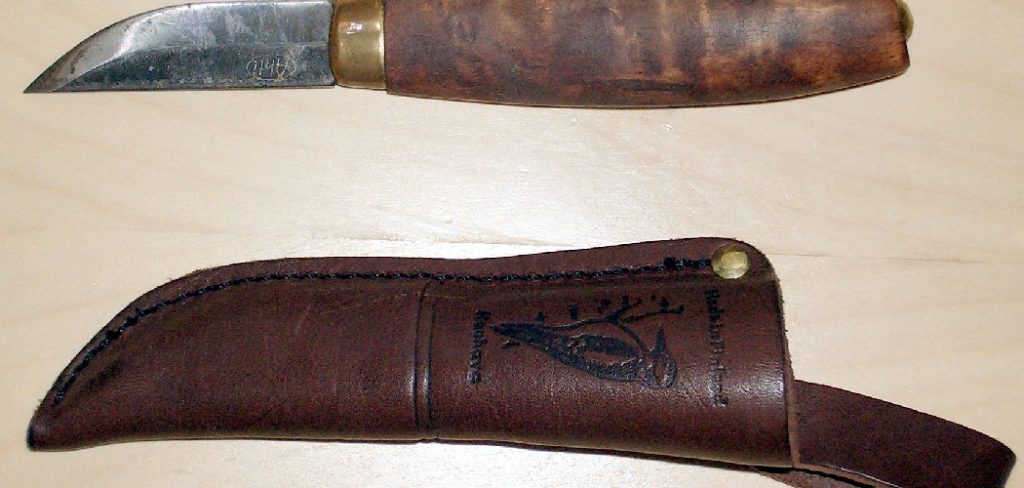
How to care for a carbon steel knife is essential to ensure its longevity and maintain its sharpness. Unlike stainless steel knives, carbon steel blades are more prone to rust and discoloration. However, they offer superior sharpness and edge retention, making them a favorite among professional chefs and cooking enthusiasts. Proper maintenance involves regular cleaning, careful storage, and routine sharpening. Understanding the specific needs of carbon steel will enhance its performance and extend the life of your knife, making it a reliable tool in your kitchen.
This guide will provide you with essential tips and techniques to keep your carbon steel knife in excellent condition.
What Will You Need?
Before diving into the care instructions, gathering all the necessary tools and materials for properly maintaining your carbon steel knife is important. Here are some items you may need:
- Mild dish soap or specialized knife cleaner
- Soft sponge or cloth
- Hot water
- Food-grade mineral oil
- Knife sharpener (whetstone, honing rod, or electric sharpener)
These items will make it easier to keep your carbon steel knife in top shape. Now, let’s move on to the care and maintenance steps.
10 Easy Steps on How to Care for a Carbon Steel Knife
Step 1. Clean Immediately After Use
After using your carbon steel knife, it’s crucial to clean it promptly to prevent any moisture or acidic residues from damaging the blade. Start by rinsing the knife under warm water to remove any loose debris or food particles. Apply a small amount of mild dish soap or specialized knife cleaner to a soft sponge or cloth and gently scrub both sides of the blade. Avoid using abrasive materials such as scouring pads or harsh detergents, as these can scratch or dull the surface of the knife. Once the blade is clean, rinse it thoroughly under hot water to ensure no soap residue remains.
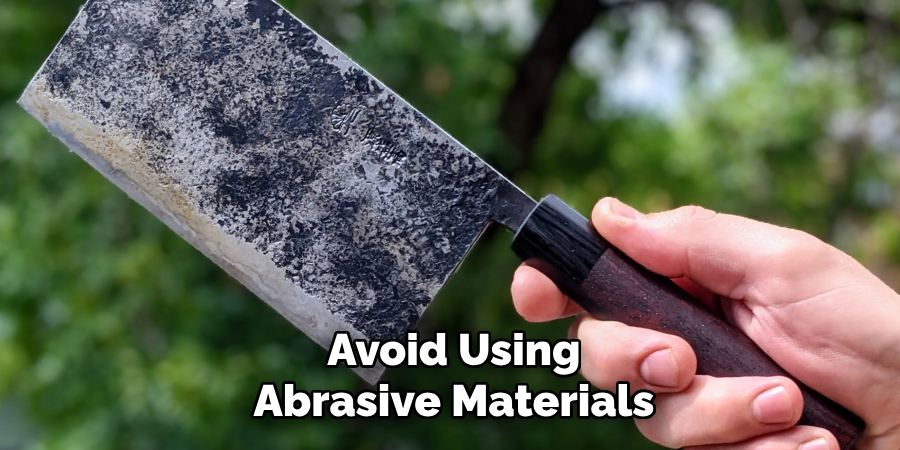
Step 2. Proper Drying Techniques
Ensuring your carbon steel knife is completely dry before storage is critical in preventing rust and corrosion. After washing and rinsing the knife, immediately take a clean, dry cloth or towel and carefully dry the blade, handle, and crevices. Pay special attention to areas where water could accumulate. Avoid allowing the knife to air dry; even minimal moisture can lead to rust spots or discoloration. Once you’ve confirmed the knife is completely dry, store it in a safe and dry place to maintain its quality and performance.
Step 3. Apply a Protective Layer
To preserve the integrity of your carbon steel knife and prevent rust, it’s essential to apply a protective layer after cleaning and drying. Use a food-grade mineral oil or a dedicated knife oil to coat the blade lightly. Add a drop or two of the oil to a soft cloth or paper towel, then gently wipe it across the entire blade surface. This thin layer is a barrier against moisture and oxidation, ensuring the knife remains sharp and rust-free. Use sparingly, as excessive oil can attract dust or leave a greasy residue. Applying this protective layer regularly, especially after each use, will enhance the longevity of your carbon steel knife.
Step 4. Store the Knife Properly
Storing your carbon steel knife correctly is vital to maintaining its condition and ensuring safety in the kitchen. Avoid leaving the knife in a drawer unprotected, as this can damage the blade or even cause accidents. Instead, consider using a knife block, magnetic strip, or knife sheath for safe storage. These options protect the blade from nicks and dulling and help prevent rust by minimizing contact with moisture-rich environments. Keeping the knife in a well-ventilated area further reduces the risk of rust development.
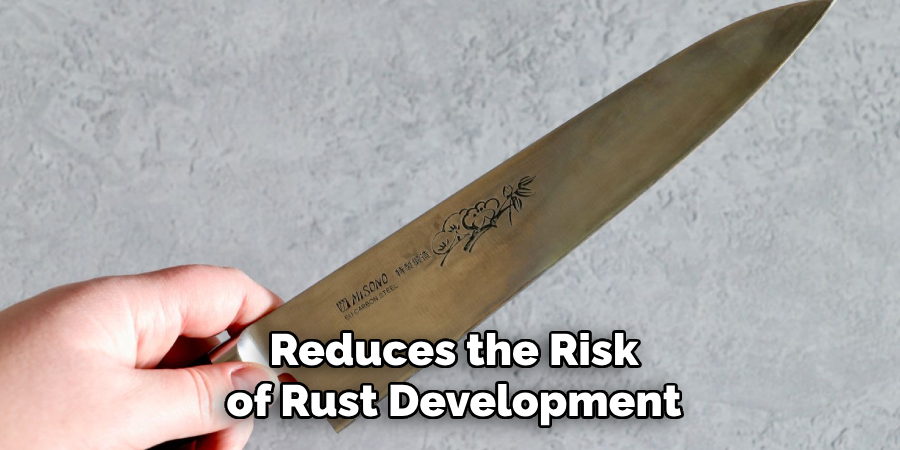
Step 5. Regular Sharpening
Maintaining the sharpness of your carbon steel knife is crucial for efficient and safe cooking. Regularly sharpen your knife using a whetstone, honing rod, or electric sharpener to ensure it remains in peak condition. Determine the sharpening angle recommended for your specific knife, usually between 15 to 20 degrees. When using a whetstone, soak it in water for 10-15 minutes to ensure effective sharpening. Gently run the blade across the stone, maintaining a consistent angle throughout each stroke.
If using a honing rod, carefully glide the blade along the rod at the same angle to straighten and refine the edge. Regular sharpening not only enhances cutting performance but also prolongs the lifespan of your carbon steel knife.
Step 6. Avoid Cutting on Hard Surfaces
To protect the edge and sharpness of your carbon steel knife, it’s important to choose appropriate cutting surfaces. Avoid using hard surfaces such as glass, stone, or ceramic, as these can quickly dull the blade and cause chipping. Instead, opt for softer materials like wood or plastic cutting boards, which are gentler on the knife’s edge. Additionally, make sure the cutting board is stable and non-slip to ensure precision and safety during use. By selecting the right cutting surfaces, you can significantly extend the life and performance of your carbon steel knife, keeping it sharp and reliable for all your culinary tasks.
Step 7. Use the Right Technique
Using the proper cutting technique is essential to maintain the sharpness and integrity of your carbon steel knife. Hold the knife firmly with your dominant hand, ensuring your grip is secure and comfortable. Avoid excessive force, as this can increase the likelihood of damaging the blade. Instead, let the knife’s sharp edge do the work by using smooth, even strokes tailored to the specific cutting task at hand. Avoid twisting or bending the knife, especially when navigating tougher or denser ingredients.
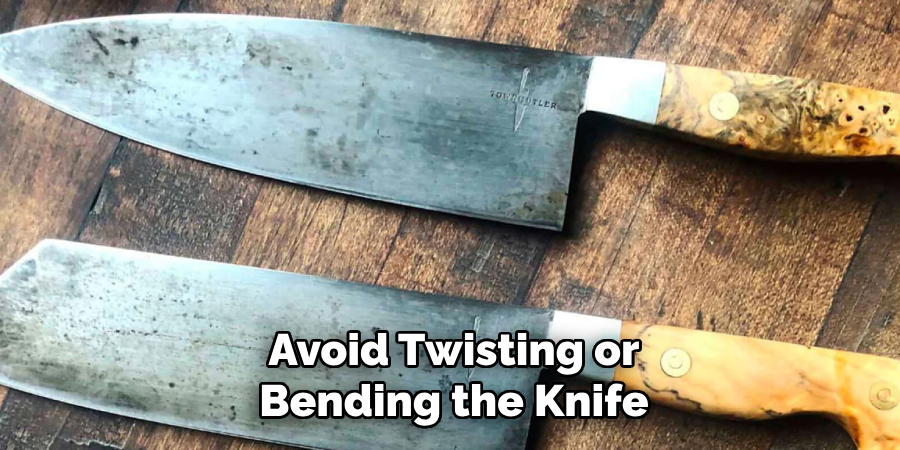
Step 8. Regular Maintenance and Inspection
Incorporating regular maintenance and inspection into your routine is essential to sustain the performance and condition of your carbon steel knife. Periodically examine the blade for any signs of rust, dulling, or damage, addressing these issues promptly to prevent further deterioration. Check the handle and any rivets or fittings, ensuring they remain secure and intact.
Inspecting the knife regularly allows you to identify and resolve minor problems before they escalate. This proactive approach, combined with consistent care practices like cleaning, drying, and sharpening, will help maintain the knife’s functionality and extend its lifespan, allowing it to remain a reliable tool in your culinary arsenal.
Step 9. Reconditioning and Repairs
Inevitably, even the most well-maintained carbon steel knife will experience wear over time. In such cases, reconditioning and repairs become necessary to restore its original performance. Start by assessing the damage or wear on the blade and handle. If the blade has significant rust or edge damage, consider seeking professional sharpening or reprofiling to bring it back to life. A gentle scrubbing with a rust eraser or fine steel wool, followed by thorough cleaning and oiling, can often suffice for minor rust.
Should the handle become loose or damaged, handle replacements or rivet tightening may be required. Investing in these repairs when needed ensures that your carbon steel knife continues to serve you effectively in the kitchen for many more years.
Step 10. Safe Handling Practices
Incorporating safe handling practices is crucial when working with carbon steel knives to prevent injury and maintain control. Always ensure a firm grip on the knife, keeping your fingers clear of the blade’s edge. Pay attention to your surroundings, providing ample space for cutting without interference. Never attempt to catch a falling knife. Instead, step back to avoid potential injury. When passing the knife to someone else, always offer the handle first, maintaining awareness of the sharp edge.
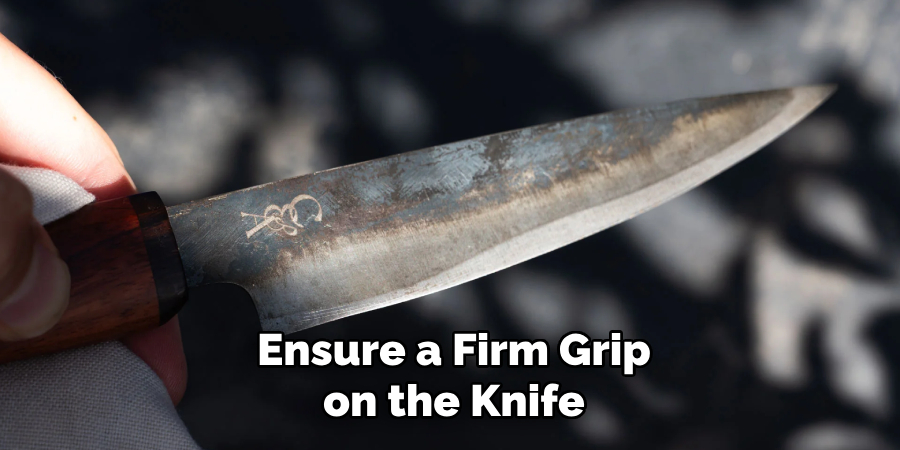
By following these ten steps for caring for and maintaining your carbon steel knife, you can ensure its longevity, performance, and safety in the kitchen.
5 Things You Should Avoid
- Leaving the Knife Wet: Moisture is the enemy of carbon steel knives. Leaving them wet can lead to rust and corrosion. Always ensure you dry the knife thoroughly after washing.
- Using Abrasive Cleaners: Avoid using harsh or abrasive cleaners that can scratch the blade’s surface. Instead, use gentle dish soap and a soft sponge to clean your knife.
- Dishwasher Use: Do not put your carbon steel knife in the dishwasher. The harsh detergents and high heat can damage the blade and handle. Always hand wash your knife.
- Neglecting Regular Oil Treatments: Periodic oiling of the blade is essential to prevent rust and maintain the knife’s sheen. Use food-grade mineral oil or similar lubricants tailored for knife care.
- Improper Storage: Tossing your knife into a drawer can dull the blade and pose safety risks. Use a knife block, magnetic strip, or blade guard to safely store your knife and preserve its edge.
Conclusion
How to care for a carbon steel knife is crucial to maintaining its performance and longevity.
Following these guidelines ensures that your knife remains in excellent condition. Always keep the blade dry after use to prevent corrosion, and use gentle cleaning methods to avoid damaging the surface. Regularly apply oil to the blade to protect it from rust and maintain its luster. Avoid exposing your knife to a dishwasher’s harsh environment; instead, opt for careful hand washing. Finally, pay attention to safe storage practices to preserve the sharpness of the blade and reduce safety hazards.
With these practices, your carbon steel knife will remain a reliable tool in your kitchen for years to come.
Edmund Sumlin is a skilled author for Metal Fixes, bringing 6 years of expertise in crafting a wide range of metal fixtures. With a strong background in metalwork, Edmund’s knowledge spans various types of fixtures, from decorative pieces to functional hardware, blending precision with creativity. His passion for metalworking and design has made him a trusted resource in the industry.
Professional Focus:
- Expert in Metal Fixtures : Edmund aesthetic specializes in creating durable and innovative metal fixtures, offering both appeal and functionality. His work reflects a deep understanding of metalworking techniques and materials.
- Sustainability Advocate : He is dedicated to using sustainable practices, ensuring that every fixture is crafted with eco-friendly methods while maintaining high-quality standards.
In his writing for Metal Fixes, Edmund provides valuable insights into the latest trends, techniques, and practical advice for those passionate about metal fixtures, whether they are professionals or DIY enthusiasts. His focus on combining artistry with engineering helps others discover the true potential of metal in design.


